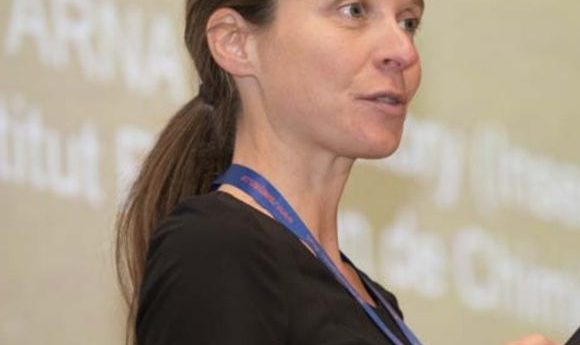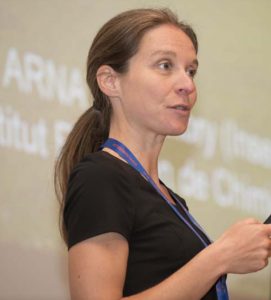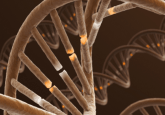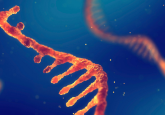Valérie Gabelica on native mass spectrometry for nucleic acids

We take a look back at the ‘Celebration of Native Mass Spectrometry’ in Oxford (UK), where we caught up with Valérie Gabelica to talk about her research and some of the current points of contention in native mass spectrometry.

Would you like to introduce yourself and your institution?
My name is Valérie Gabelica. I work at the Institut Européen de Chimie et Biologie (IECB) in Bordeaux. I moved here 6 years ago to set up an independent group. The IECB is an incubator for young team leaders to start up their independent research in the French system.
Could you tell us a bit about the research that you’re doing there at the moment?
I’m conducting native mass spectrometry (NMS) of nucleic acids, which is slightly more uncommon amongst the attendees and speakers here, where most people are studying proteins. I started that when I was doing my PhD in Liège, Belgium. I always had collaborations with biophysicists working on the nucleic acid side and they saw an interest in NMS. So, thanks to this continued interest I kept my motivation to study nucleic acids by MS, maybe slightly contrary to the mainstream, but it combined my two favorite topics.
What is it that you’re currently working on now?
Our research has two aspects. We want to learn more about the folding biophysics of G-quadruplex nucleic acids, as you may have heard from the presentation earlier this morning from Dr Ghosh of my group. There are some aspects of the folding that we can reveal quite readily with MS, and which are difficult to get a hint of with traditional biophysical techniques. We also brought our contributions to the understanding of the folding of quadruplex nucleic acids in particular. My other main interest is in the basic understanding of how NMS works and how we could go further to get information on the structure of the different species that we can separate with MS. Ion mobility is one of the areas I’m looking at, and ion spectroscopy is another technique that I am interested in.
And where do you think your research could lead in the future?
Let’s talk about NMS. It’s still difficult to have it accepted among the panel of tools in the biophysics laboratories. In structural biology it has perhaps become more popular, thanks to the contributions of the Oxford group here in the first place. However, in other fields like structural chemistry and biophysics, there is always this suspicion about NMS, because we are analyzing things in the gas phase and we want to infer information on what existed in the solution. In every community you have to convince and prove that what you are claiming to deduce from MS is valid. In different communities it’s a different challenge. For example, among organic chemists and supramolecular chemists, a few are really convinced, but most will want to crystallize the structure and analyze it by NMR, because that is more conventional and thus better accepted by their peers.
If you were thinking about the challenges to your research at the moment, would you say that skepticism to NMS is one of the biggest challenges that you are facing? Or would you say there are other things that hinder you more?
It’s not necessarily the main challenge, but inferring information on the solution structure based on the MS or ion mobility information is a complex problem because there are several unknowns in the process. For instance, the structural changes when you spray a sample from solution into the gas phase, and how the instruments influence your ions. There are uncertainties in the methodologies themselves, either from the instrument conception side or for the underlying concepts for interpretation.
So, there are theoretical challenges as well as practical challenges. Handling these quite complex problems and questions to build a solid theory and a solid way to interpret data need to be tackled.
Finally, it seems that, even here, there is a little bit of dispute about some of the terminologies and definitions. What you can define as stability, for example. Can you explain this point of contention?
I think that in some of the examples that were shown this morning, ‘stability’ was not the proper word to use, and it could be misleading. You are activating the ions by increasing a voltage in the instrument and then you are observing the result. The result can be an unfolding, as was discussed, or a dissociation.
If it has unfolded the protein will not fold back, because unfolding is due to the coulomb repulsion between the like charges. This means that it is not an equilibrium back and forth between two states, so not the situation in which you usually use the word ‘stability’. In this instance, we need to think in terms of kinetics, not equilibria. Of course, in some instances, there will be a similar ranking between the rate of dissociation at a given voltage and the analyte’s true stability, but we should not take it for granted and oversimplify things.
Maybe we could use the term ‘kinetic stability’ when speaking about MS collision-induced dissociation or collision-induced unfolding, which is probably a bit more complicated and less intuitive than talking about stability. On the other hand, it would clarify what we actually measure.





